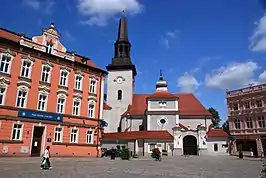Jarocin
Jarocin ([jaˈrɔt͡ɕin]) (German: Jarotschin) is a town in central Poland with 25,700 inhabitants (1995), the administrative capital of Jarocin County. Since 1999 Jarocin has been located in Greater Poland Voivodeship, prior to that it was located in the Kalisz Voivodeship (1975–1998).
Jarocin | |
|---|---|
  St Martin's Church with marketplace (top) and town hall (bottom) | |
 Coat of arms | |
 Jarocin  Jarocin | |
| Coordinates: 51°58′N 17°30′E | |
| Country | |
| Voivodeship | Greater Poland |
| County | Jarocin County |
| Gmina | Gmina Jarocin |
| Established | 13th century |
| Town rights | 1257 |
| Government | |
| • Mayor | Adam Pawlicki |
| Area | |
| • Total | 14.44 km2 (5.58 sq mi) |
| Population (2006) | |
| • Total | 25,834 |
| • Density | 1,800/km2 (4,600/sq mi) |
| Time zone | UTC+1 (CET) |
| • Summer (DST) | UTC+2 (CEST) |
| Postal code | 63-200 |
| Area code(s) | +48 62 |
| Car plates | PJA |
| Climate | Cfb |
| Website | http://www.jarocin.pl/ |
Jarocin is a historical town, having been founded and granted city rights in the 13th century.[1] The marketplace features a Ratusz town hall built between 1799 and 1804, which is now home to the Jarocin Regional Museum.
The town also became famous in the 1980s thanks to the Jarocin Festival, one of the first rock-punk music festivals of the former Warsaw Pact and in Europe. The first event was organised in 1980.[2]
History

The lordship of Jarocin was first mentioned in a 1257 deed issued by Duke Bolesław the Pious of Greater Poland. The town was conveniently located at the intersection of the trade routes from Wrocław to Toruń and from Poznań to Kalisz. It was a private town of Polish nobility, administratively located in the Pyzdry County in the Kalisz Voivodeship in the Greater Poland Province of the Polish Crown.[3]
Jarocin was annexed by the Kingdom of Prussia in the 1793 Second Partition of Poland and administered within South Prussia. It was part of the Duchy of Warsaw from 1807–13 during the Napoleonic Wars, but was restored to Prussia afterwards. The town was included within the Grand Duchy of Posen from 1815 and the Province of Posen from 1848. It became part of the German Empire in 1871. In 1889 it was included within the newly created Jarotschin District of the Province of Posen.
Jarocin participated in the Greater Poland Uprising (1918–1919) and had the first soldiers' council in the Province of Posen. Polish insurgents captured the local military barracks and rail junction on November 8-9, 1918, just days before Poland declared independence on November 11.[4] It was subsequently included in the Second Polish Republic. 42 Polish insurgents from Jarocin and nearby settlements were killed in the uprising.[4] In the interbellum Jarocin was a county seat in the Poznań Voivodeship.
The town was annexed by Nazi Germany in 1939 during World War II and administered within Reichsgau Wartheland as part of the district or county (kreis) of Jarotschin. Poles arrested during the Intelligenzaktion were imprisoned in the local prison.[5] Many Polish citizens, especially Jews, were expelled and replaced with ethnic Germans from the Baltic states, Volhynia, and Bukovina in accordance with the German Lebensraum policy. Many inhabitants were also deported to forced labour in Germany.[1] The Germans devastated the memorial at the mass grave of the fallen Polish insurgents of 1918–1919.[4] A forced labor prison operated in the vicinity from January 1941 to January 1945.[6] Nevertheless, the Polish resistance movement was organized in the town, including the Secret Military Organization and structures of the Polish Underground State.[7] Following the arrival of the Red Army and the end of the war in 1945, Jarocin was restored to Poland, however with a Soviet-installed communist regime, which then stayed in power until the Fall of Communism in the 1980s. The devastated insurgents' tombstone was renovated in 1948.[4]
Sights

Main landmarks and points of interest include the old Radoliński Palace with an adjacent park, the Polish Rock Granary, a museum dedicated to Polish rock music, the Rynek (Market Square) filled with historic architecture, including the town hall, which also houses the historic museum, and the St. Martin's Church, and several Greater Poland Uprising memorials.[4]
Sports
The town's most notable clubs are rugby union team Sparta Jarocin, which competes in the Ekstraliga (Poland's top division), and football team Jarota Jarocin, which competes in the lower leagues.
Twin towns
Jarocin is twinned with:
 Libercourt, France
Libercourt, France Veldhoven, Netherlands
Veldhoven, Netherlands Hatvan, Hungary
Hatvan, Hungary Schlüchtern, Germany
Schlüchtern, Germany Oleksandriia, Ukraine
Oleksandriia, Ukraine Korkuteli, Turkey
Korkuteli, Turkey
Gallery
 Rynek (Market Square) filled with colourful historic townhouses
Rynek (Market Square) filled with colourful historic townhouses Radoliński Palace
Radoliński Palace Radoliński Park
Radoliński Park St. George Church
St. George Church Jarocin Festival, 1984
Jarocin Festival, 1984_Lichen99.jpg.webp) Railway station
Railway station
People
- Eduard Lasker (1829–1884), politician
- Gustav Wegner (1903–1942), German athlete
- Dame Elisabeth Schwarzkopf (1915–2006), operatic lyric soprano
- Czesław Madajczyk (1921–2008), Polish historian
- Sławomir Majusiak (born 1964), Polish long-distance runner
- Robert Baran (born 1994), Polish wrestler
References
- "Jarocin - Dzieje miast - Region Wielkopolska - a must see". regionwielkopolska.pl. Retrieved 26 June 2017.
- "Jarocin'17". jarocinfestiwal.pl. Retrieved 26 June 2017.
- Atlas historyczny Polski. Wielkopolska w drugiej połowie XVI wieku. Część I. Mapy, plany (in Polish). Warszawa: Instytut Historii Polskiej Akademii Nauk. 2017. p. 1b.
- "Jarocin (miasto powiatowe)". Instytut Pamięci Narodowej (in Polish). Retrieved 26 December 2020.
- Wardzyńska, Maria (2009). Był rok 1939. Operacja niemieckiej policji bezpieczeństwa w Polsce. Intelligenzaktion (in Polish). Warszawa: IPN. p. 117.
- Zwansarbeit in NS-Staat. German Federal Archive (Bundesarchiv). Accessed 9-30-11.
- Pietrowicz, Aleksandra (2011). "Konspiracja wielkopolska 1939–1945". Biuletyn Instytutu Pamięci Narodowej (in Polish). No. 5–6 (126–127). IPN. pp. 32, 36. ISSN 1641-9561.
